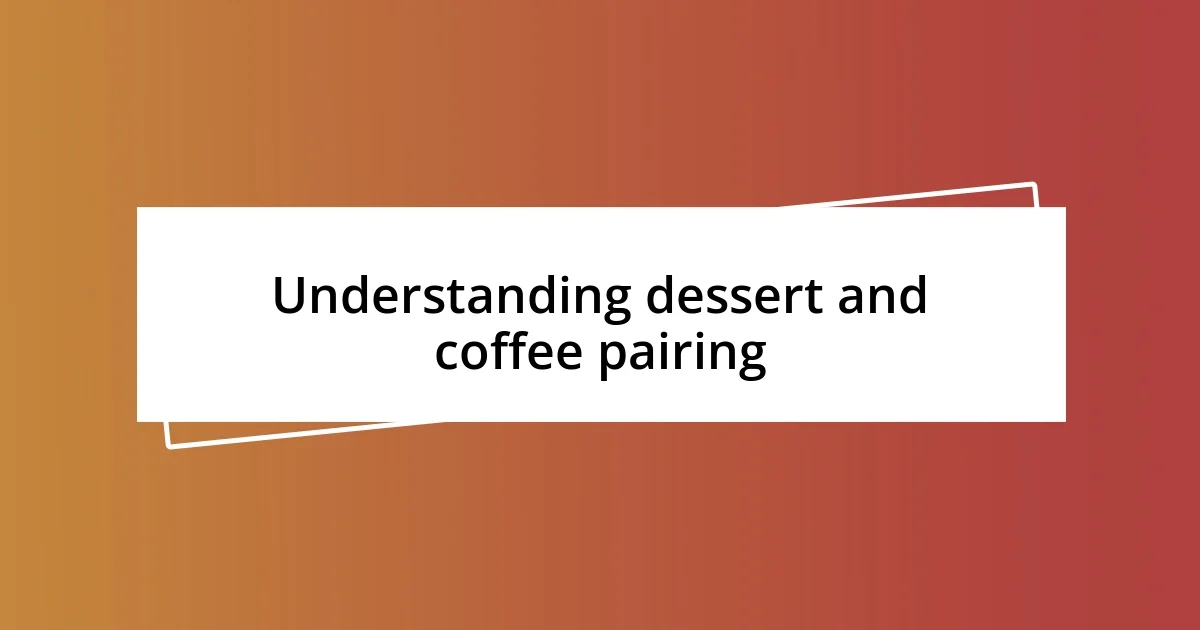Key takeaways:
- Pairing dessert and coffee enhances flavors; rich and bold combinations like dark chocolate with espresso create memorable experiences.
- Identifying dessert flavor profiles (fruity, nutty, rich, creamy) helps in selecting the right coffee type for optimal pairing.
- Exploring regional pairings, such as tiramisu with espresso in Italy, reveals unique culinary traditions and enhances the dining experience.

Understanding dessert and coffee pairing
Pairing dessert and coffee is like creating a harmonious duet; each element can enhance the experience of the other. I still remember the first time I tried a rich dark chocolate cake with a bold espresso. The bittersweet notes of the cake played beautifully against the roasted flavor of the coffee, making each bite and sip a little more special.
Have you ever felt that a certain dessert just sparks joy? For me, it’s a creamy tiramisu alongside a smooth cappuccino. The layers of coffee-soaked cake and rich mascarpone cream, when complemented by the frothy milk, elevate the whole experience to something divine. It’s moments like this that teach us just how much the flavors can intertwine and surprise the palate.
Understanding the right combinations takes a bit of practice, but it’s so rewarding. Think about the texture and sweetness of desserts—when paired with a coffee that has hints of nuttiness, it’s pure magic. I once experimented with a lemon meringue pie and a light roast coffee, and the zesty brightness made my taste buds dance. What unexpected pairings have you tried that left an impression on you?

Choosing the right coffee type
Choosing the right coffee type can truly elevate your dessert experience. Personally, I find that a medium roast works wonders with pastries like croissants and fruit tarts. The balance of acidity and sweetness in medium roasts seems to enhance the buttery notes of the pastry while complementing the fresh fruit flavors. Have you ever noticed how a good cup of coffee can bring out the best in a dessert?
For richer, denser desserts like cheesecake, I often gravitate towards a dark roast. The deep, bold flavors of the coffee create a lovely contrast with the creamy texture of the cheesecake, making each bite a delight. There’s something so satisfying about the way the full-bodied coffee cuts through the richness, creating a balanced forkful that feels indulgent yet harmonious. The pairing transports me back to cozy cafés where I first discovered this combination, and I cherish those moments.
When it comes to lighter desserts such as meringues, I suggest exploring a floral or fruity coffee. These types can offer a refreshing taste that aligns beautifully with the airy sweetness of the meringue, awakening the palate. I remember enjoying a lavender-infused coffee paired with a lemon meringue, and the bright, fragrant notes played off each other perfectly, nearly singing on my taste buds. What are the coffee types you lean toward when selecting desserts?
| Coffee Type | Best Paired With |
|---|---|
| Medium Roast | Pastries, Fruit Tarts |
| Dark Roast | Cheesecake, Chocolate Cake |
| Floral/Fruity Coffee | Meringues, Light Desserts |

Identifying dessert flavor profiles
Identifying dessert flavor profiles can feel like decoding a delicious mystery. Each dessert brings its own personality, from fruity and refreshing to rich and indulgent. I still recall the first time I savored a lemon tart; the bright citrus notes danced on my tongue like a zesty celebration, complementing a light, herbal coffee that mirrored its vibrancy perfectly.
Here are some common dessert flavor profiles to consider:
– Fruity: Think lemon, berry, or stone fruits. They often pair well with coffee that has bright acidity or floral notes.
– Nutty: Desserts that feature nuts, like almond cake or pecan pie, find a wonderful partner in medium roasts with earthy undertones.
– Rich and Decadent: Dark chocolate or caramel desserts call for bold coffees, especially dark roasts that offer deep, roasted flavors.
– Creamy: Cheesecake or panna cotta benefits from smoother coffees, like a latte or cappuccino, which enhance their silky textures.
By recognizing these flavor profiles, you can elevate your pairing game significantly. When I experimented with a pistachio cake, I was surprised at how a lightly roasted coffee with nutty notes brought out the unique essence of the dessert, making me appreciate the pairing on a whole new level. It’s these little revelations in flavor matching that make the art so rewarding.

Balancing sweetness and bitterness
Finding the right balance between sweetness and bitterness is essential for creating memorable coffee and dessert pairings. I’ve often found that a hint of bitterness can beautifully contrast a dessert’s sweetness, grounding it and preventing the flavors from overwhelming the palate. For instance, I once paired a rich chocolate mousse with an espresso that had a robust, slightly bitter profile, and the combination was like a harmonious dance of flavor that left me craving more.
What about the times when sweetness seems to overshadow everything? I remember enjoying a slice of vanilla bean cheesecake that was incredibly rich and sweet. To complement it, I opted for a slightly bitter cold brew, and it was eye-opening. The cold brew’s bold flavor cut through the creaminess, creating a balance that had me truly savoring each bite. This balance is crucial, in my opinion, as it elevates both the coffee and dessert experience, letting each component shine.
Sometimes, experimenting is the key to discovering that perfect balance. Have you ever tried a dessert that seemed overly sweet but became delightful when paired with a coffee that had a bitter edge? During one gathering, a friend brought a caramel tart, which I thought was going to be too much. But I paired it with a dark roast that had a nice bitterness, and to my surprise, the flavors melded beautifully. It’s these unexpected pairings that often yield the most joy in the journey of discovering flavors.

Enhancing pairings with textures
When it comes to enhancing pairings with textures, I always consider the contrast as a key element. Take, for instance, a velvety chocolate torte paired with a crunchier coffee dessert like a biscotti. The interplay between the creamy torte and the firm bite of the biscotti brings an exciting dynamic to the experience, each texture elevating the other. Do you feel how that crunch can make the rich chocolate feel even more indulgent?
In another memorable experience, I paired a smooth panna cotta with a coffee that had a frothy texture, like a cappuccino. As I took a spoonful of the silky dessert and sipped the creamy coffee, it felt like a luxurious embrace. Each component complemented its counterpart, and the marriage of textures made each bite and sip a celebration of harmony. Have you ever felt that luxurious contrast on your palate?
I’ve also enjoyed a delightful pairing of a flaky pastry with a bold, full-bodied brew. The crisp layers of the pastry against the deep coffee made for a sophisticated experience. It’s in those moments that textures truly shine; the layers of the pastry added a delightful crunch while the coffee provided a comforting, warming sensation. Isn’t it fascinating how texture can transform a simple pairing into something extraordinary?

Tips for creating perfect combinations
When I think about creating perfect combinations, one of my top tips is to consider temperature contrasts. Serving a warm dessert, like a molten lava cake, alongside an icy cold brew can be an amazing experience. I once had this pairing, and the contrast between the warm, gooey cake and the refreshing cold coffee felt like a delightful surprise, awakening all my taste buds at once—have you ever experienced that delightful shock on your palate?
Another thing that stands out to me is the role of flavors beyond sweetness and bitterness. Try incorporating spices or herbal notes into your combinations. I find that pairing a chai latte with a cinnamon roll creates a celebration of warm spices that enhances both. The rich, aromatic qualities of the chai complemented the soft sweetness of the roll beautifully. Have you ever tried this? It’s as if the flavors were meant to be together, creating a cozy atmosphere with every bite and sip.
Lastly, don’t shy away from unusual pairings. One evening, I was feeling adventurous and paired an olive oil cake with a citrusy espresso. Strangely enough, the grassy notes from the cake blended seamlessly with the bright acidity of the coffee, bringing forth unexpected layers of flavor. Would you have ever thought that a fruity coffee could complement such a savory, olive-oil-forward dessert? It’s those daring pairings that can manifest a unique tasting experience that stays with you long after the last bite.

Exploring regional pairings and traditions
I’ve been fortunate enough to explore regional dessert and coffee pairings, and each culture seems to have its own unique story. For instance, when I visited Italy, I was enchanted by the way locals paired the iconic tiramisu with a shot of rich espresso. The layers of coffee-soaked ladyfingers perfectly complemented the bitterness of the espresso, bringing out the delightful creaminess in a way that felt like a love letter to the palate. Have you ever tasted a pairing that felt like it told a story?
In contrast, during my travels in France, I discovered the joy of combining a delicate madeleine with a bright, floral café au lait. The subtle flavors of the buttery cake swirled together with the aromatic coffee created a gentle dance in my mouth. I can still recall the soft notes of both elements, inviting me to slow down and savor the moment. Isn’t it interesting how a simple treat can transport you to another place and time?
Exploring Asian desserts also opened my eyes to unique combinations. While savoring a warm mochi filled with sweet red bean paste, I was surprised to find it pairing beautifully with a robust Vietnamese drip coffee. The intense coffee cut through the rich, sticky sweetness of the mochi, igniting an unexpected excitement. Have you experienced such delightful surprises in your culinary adventures? There’s something magical about discovering these regional traditions that transcends borders and connects us through our shared love of food and drink.














